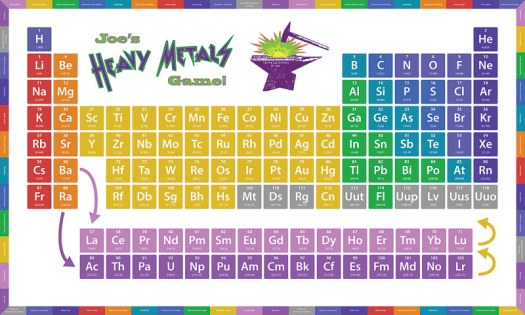Quick the links below to access Quizlet study sets and learn all the great info that will help you win the Elements game!
Click here to practice matching element names to atomic symbol and atomic number.
Click here to practice matching element names to just atomic number.
Click here to match element name to atomic symbol.
Click here for the new and improved Elements Game questions!
Click here for the Elements in-class Minilesson questions!
If you’ve ever been in my classroom upstairs at the Realm, you will have seen the great big periodic table on the wall. That was created in a class I taught a few years ago. It spent its first couple years down in the room that Linda teaches in now, but when we moved into the upstairs classrooms, I couldn’t bear too leave it behind, so I took it off the wall and transferred it upstairs – it was a little tricky!
Well, when I taught that class about the periodic table, I realized that what I really needed to do, was teach a class about the elements. That’s where this class came from. This class will alsocover a bit about the periodic table and even more about atomic structure, but it will do it from an elements first sort of perspective. If you’re curious and want a little periodic table lead-in, scroll down and watch the Crash Course video about the Periodic Table – it’s fast-paced, but if you miss any of it, you can always watch it again!
This class will explore characteristics of individual elements and groups of elements found on the Periodic Table. There will be two primary aspects to each class meeting. We’ll begin each week by doing brief research about an individual element, a group of elements, or a block in the periodic table. Each student will learn a few facts about a specific element, we’ll take turns reading through some info and then, as a group, answer a series of questions. Following that, we’ll explore the elements through gameplay.
And by gameplay, I mean Joe’s Heavy Metals Game – which honestly is usually just called “the Elements Game,” but I do still kinda like the original! I designed this game a few years ago, and it took most of the Summer, but I’m pretty happy with the way it came out. Here’s a picture of the game board.
Let’s see if I can explain how the game works. Players take turns rolling dice and moving around the board. If they can identify the name of the element from its symbol when they land on it, they get the matching card. If another player lands on an element that has already been won, and they know the element, then they get a chance to win the card from the first player – by answering a question. If they answer the question correctly, then the original winner of that card, get a chance to answer to save the card, but if they can’t answer correctly, the card goes to the new player. That sounds more confusing than it really is – it’s a lot of fun.
This year, we’ll have new and better questions. When I first made the game, I focused on getting one question per element, but after a couple years of playing it, I’ve realized that some elements are more relevant and interesting than others, so I’ve streamlined the questions to keep things exciting. Here are the new questions – I’ve put them up over at Quizlet for easy access, I encourage everybody to practice at home, so they’re really well-prepared when it comes to game-time!
Here are the game cards.
- Hydrogen
- Helium
- Lithium
- Beryllium
- Boron
- Carbon
- Nitrogen
- Oxygen
- Fluorine
- Neon
- Sodium
- Magnesium
- Aluminum
- Silicon
- Phosphorus
- Sulfur
- Chlorine
- Argon
- Potassium
- Calcium
- Scandium
- Titanium
- Vanadium
- Chromium
- Manganese
- Iron
- Cobalt
- Nickel
- Copper
- Zinc
- Gallium
- Germanium
- Arsenic
- Selenium
- Bromine
- Krypton
- Rubidium
- Strontium
- Yttrium
- Zirconium
- Niobium
- Molybdenum
- Technetium
- Ruthenium
- Rhodium
- Palladium
- Silver
- Cadmium
- Indium
- Tin
- Antimony
- Tellurium
- Iodine
- Xenon
- Caesium
- Barium
- Lanthanum
- Cerium
- Praseodymium
- Neodymium
- Promethium
- Samarium
- Europium
- Gadolinium
- Terbium
- Dysprosium
- Holmium
- Erbium
- Thulium
- Ytterbium
- Lutetium
- Hafnium
- Tantalum
- Tungsten
- Rhenium
- Osmium
- Iridium
- Platinum
- Gold
- Mercury
- Thallium
- Lead
- Bismuth
- Polonium
- Astatine
- Radon
- Francium
- Radium
- Actinium
- Thorium
- Protactinium
- Uranium
- Neptunium
- Plutonium
- Americium
- Curium
- Berkelium
- Californium
- Einsteinium
- Fermium
- Mendelevium
- Nobelium
- Lawrencium
- Rutherfordium
- Dubnium
- Seaborgium
- Bohrium
- Hassium
- Meitnerium
- Darmstadtium
- Roentgenium
- Copernicium
- Nihonium
- Flerovium
- Moscovium
- Livermorium
- Tennessine
- Oganesson
Here is a really great video from Crash Course Chemistry to give you a little background info about the Periodic Table, in case you missed last year’s Periodic Table class, or if you just want a little refresher. It’s a pretty great video and worth watching and rewatching until you’ve got it word for word (or at least until you get bored with it)! Also, be sure to scroll down and check out some of the links to other chemistry focused websites.
Here are some great links to learn more about the elements:

